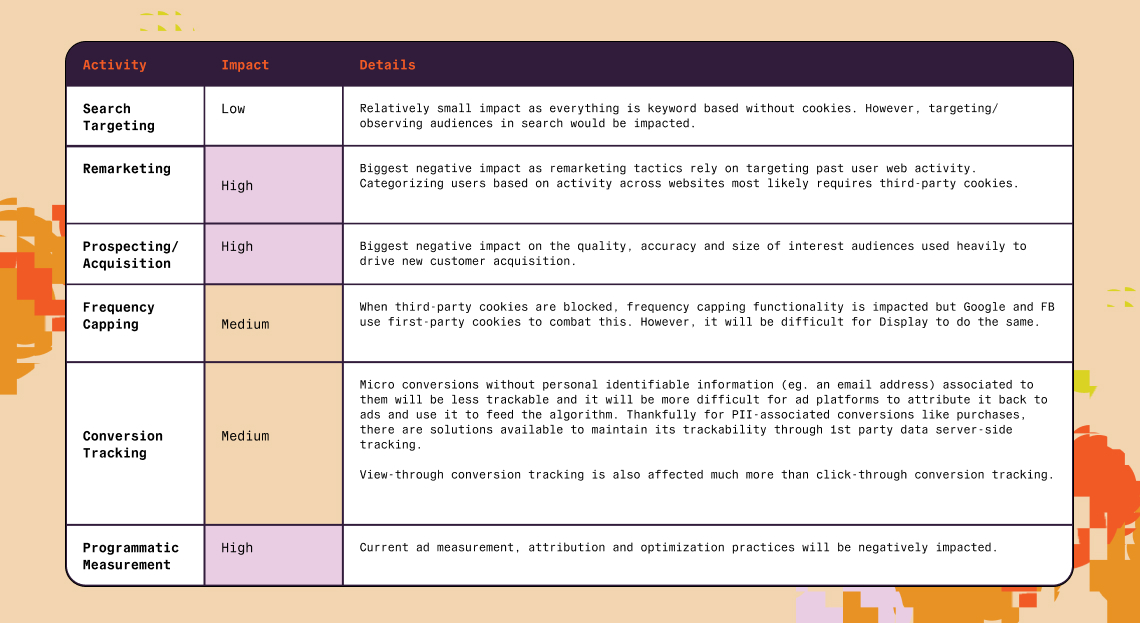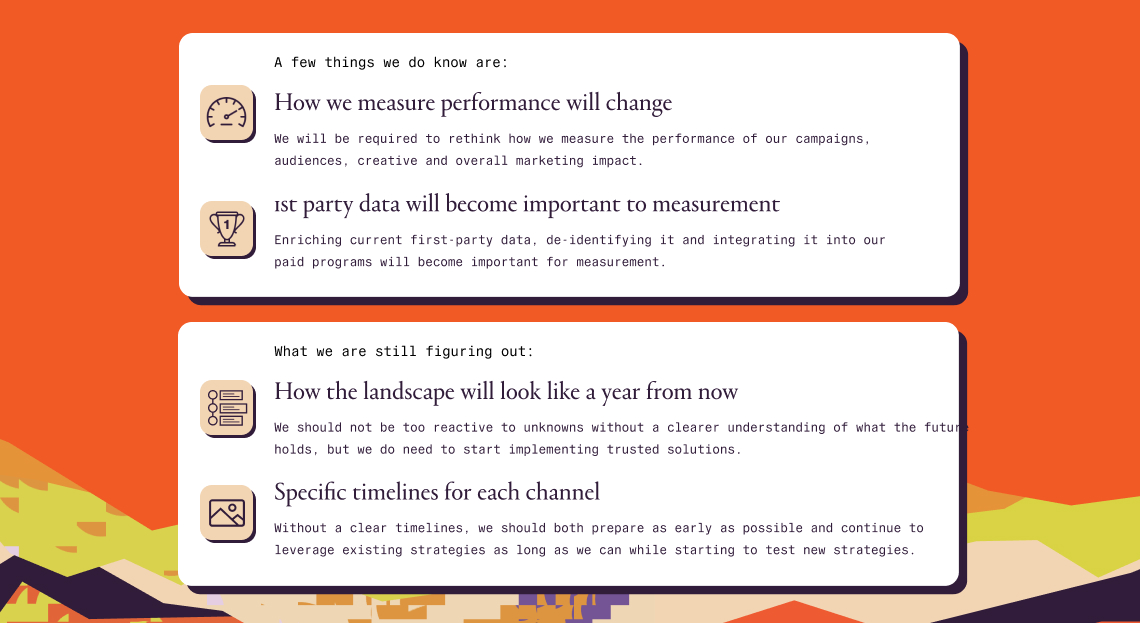
TL;DR cookies are pieces of information about a user’s characteristics and behaviors that the user’s web browsers store as code every time they visit a website. Currently, Chrome alone has 63% of browsers globally so when they remove cookies, it’s a BIG deal. Cookies are the foundation of digital marketing targeting, tracking, and impactfulness — due to consumer privacy concerns, Chrome is getting rid of them. Likely by mid-2024 (but TBD, Google keeps pushing it back so keep an eye on the timeline here).
Here are 7 things you can do to navigate this changing landscape:
1) Leverage AI based features
2) Utilize contextual targeting
3) Implement GA4
4) Server-side tracking
5) Be transparent about data privacy
6) Collect 👏🏽 first 👏🏽party👏🏽 data 👏🏽
7) When in doubt, work with a specialty performance marketing agency like Thrive
8) Implement incrementality testing
What are cookies and why should we care?
Let’s start at the beginning. Cookies are “pieces of information about a user’s characteristics and behavior that the user’s web browser stores as code every time they visit a website,” (as defined by our friends at Google). They’re the current foundation of many digital marketers paid strategy and (here’s the scary part) they’re going away.
In this article we’re going to dig into the nitty gritty of how cookies work now, what the proposed timeline is for them going away, how you can prepare, and what happens next.
Generally speaking, cookies can store any number of information specific to a user making them extremely useful to advertising platforms like Google Ads who use them to create personalized audience targeting options, smart learning, and measurement tools offered to advertisers for their marketing purposes i.e. target ads to a specific user profile.
Types of information stored in cookies can be broken down into two buckets, User specific and User activity/behavior.

Users who don’t opt-out of cookie tracking have cookies stored on their browser, which will remain and continue storing that user’s information as long as it isn’t removed. Cookies can be later assessed by the cookie provider at any point to get the user’s past website history.
What are the types of cookies?
There are two types of cookies: first-party cookies and third-party cookies.

It’s important to note, data measurement platforms use a combination of first and third-party cookies for data collection.
Third-party cookies are going away
With modern privacy concerns, we’re entering a new state of marketing.
The digital advertising landscape is experiencing a paradigm shift. People’s trust in digital is in decline as they become more concerned with how companies are using their data. Businesses are also seeing a direct impact based on consumer trust and many global consumers have stopped buying or using a service from a company due to privacy concerns (check out this article from Pew Research for more information).
As a result, the advertising industry is shifting to meet higher customer standards. As users demand more control and transparency over data collected and used for ads personalization, Google is responding by replacing third-party cookies with privacy-preserving APIs sometime in 2024 (though this timeline is continually being moved so take it with a grain of salt).
3rd party cookies are currently heavily used to track individual users across the web and power a lot of the paid marketing capabilities we know and use to run and optimize paid marketing spend like conversion reporting, audience targeting, and smart bidding.
This tracking method isn’t very easy for consumers to understand, undermines user privacy, and dampens their experience which is why Google is moving away from cookie tracking and towards a future where tracking is consented, cookieless, and modeled.
What does Google mean by consented, cookieless, and modeled?
Consent: Google will prioritize relying on 1st party data where data collection is consented.
Cookieless: Starting in 2024, Google will start phasing out 3rd party cookies, the source of which many marketing capabilities have been reliant on to operate so far.
Modeled: Over the last decade Google has already adopted conversion modeling into its measurement methodology to attribute conversions back to ads. This way of conversion attribution will be more and more prominent in conversion attribution.
If there’s one thing we know with certainty, it’s that change is the norm. Modern marketers need to be up-to-date with the online marketing landscape and to work towards privacy-centric marketing. It’s time to be agile and experimental.
How long until third-party cookies are gone?
Third-party cookies will be blocked by Google on its Chrome browser by mid-2024 and have already been blocked by default within other browsers such as Safari and Firefox.
Third-party cookies will continue to exist but browsers make it harder for third parties to access these cookies, hence they are “blocked” from that domain.
The impact of a cookieless state on paid marketing
Let’s get the tough part out of the way first: a number of marketing capabilities will be negatively impacted. But don’t you worry, Google’s share prices very much depend on selling ads. Advertising isn’t going away, but the way we do it is sure changing.
The deprecation of third-party cookies will definitely reduce any advertiser’s ability to target relevant audiences, measure website KPIs, and rely on smart algorithms to the same level of accuracy available now.
We expect to see this loss of accuracy from a drop in membership numbers when it comes to audiences, a drop in website events reported and attributed back to ads, and a drop in the signals used by algorithms to optimize around set marketing objectives.

So, how much of this is real or guaranteed?
There are those who question whether 3rd party cookie deprecation will happen, or how far Google will go to protect user privacy at the cost of advertising revenue. That’s a fair question.
We 100% know that 3rd party cookies will be deprecated and there is no possibility of this not happening.
Not just because of user demands but because user privacy is something government bodies and regulators are increasingly getting involved in and are already enacting stricter policies for. Regulators have openly voiced their dislike of third party aggregated data collection and there’s already a sense of this in the many privacy lawsuits circulating the news.
The good news is immediate solutions like setting up Google enhanced conversions and Facebook conversions API don’t interfere with current paid marketing campaigns. They happen mostly in the background and definitely benefit marketing efforts with little drawbacks (though we should mention that they take quite a heavy lift from engineering and development teams). There are also new and upcoming marketing technologies being developed to replace reliance on 3rd party cookies to operate.
The bad news is these tools aren’t going to solve all of the audience quality, conversion tracking, and data signal loss that will still happen to some extent as a result of third party cookie deprecation. Therefore it’s very important solutions involve adapting marketing practices to the parameters of a cookieless environment. Running more contextual targeting, testing broad targeting, and relying on lift measurement studies to understand paid performance are all viable tactics to begin exploring.
Adapting to a cookieless state
What do you need to do?
Current solutions revolve around reducing the impact of third-party cookie deprecation rather than being complete workarounds. You will still need to shift advertising efforts to adapt to a more privacy-oriented landscape with less visibility than currently available.

What now?
It’s going to be difficult to know with any certainty what the path forward looks like with the cookieless future but there are some things we know. Here are some of our top recommendations based on currently available information and options.
Leverage AI based features
An example of some of these features include smart bidding, dynamic search ads, smart display and more to make the most of first-party data and user intent signals. Utilizing Facebook Conversions API (CAPI), Google Enhanced Conversions (EC) and customer match to collect first-party data for continued reporting and attribution is critical. When third-party cookies via pixel are blocked, CAPI and EC can still track important conversions/KPIs.
Contextual targeting
Google and other ad platforms still very much want to make money on advertising so they want to help you find targeting options that make sense, even without cookies. Utilizing their contextualize tools such as letting Google use your keywords or topics to match ads to relevant pages will help with the transition.
Implement GA4
Google has (and will continue) developing advanced modeling capabilities within GA4 to give a complete view of the user journey while building in additional data controls for both users and advertisers. The new analytics platform is designed for a cookieless future.
Server-side tracking
When marketers and advertisers collect user information on a conversion or confirmation page, they no longer send in pixels on that page in the form of cookies. Instead, once it’s collected, the marketer must send it to a server-side, backend service. That service will report to Google, Facebook, and other ad networks that a conversion has occurred. It’s worth mentioning that this option can be labor intensive and will require the assistance of either developers, engineers, or both.
Be transparent about data privacy
With 48% of people worldwide having stopped buying a product or service from a company due to privacy concerns, it’s especially important to make sure you’re transparent with the way you collect, store, and use customer data. This will help with legal compliance, brand reputation, and avoiding PR crises.
Collect 👏🏽 first 👏🏽party👏🏽 data 👏🏽
Enriching current first-party data, de-identifying it, and integrating it into your paid programs will become important for measurement. This data (willingly given to you by your audience) is actually useable without anonymization and crucial to building a relationship with those people through targeted marketing activities.
Work with a specialty performance marketing agency like Thrive
Sure, it’s a shameless plug, but this is literally our day-to-day job. We get paid to understand and help our clients navigate this challenging landscape so we’re good at it and we can help. If you’re struggling to get traction with your ad program, or if you feel lost in the cookieless sea, working with a specialized agency like Thrive can help you get the most out of your marketing dollars.
Incrementality testing
Now that ad platforms are becoming harder than ever to track, using incrementality tests to validate the impact of advertising channels on top line revenue is hugely important. We wrote a whole blog post on it here we recommend checking out.
Stay tuned to this blog for more details as they come out.
 Amanda Ng
Amanda Ng